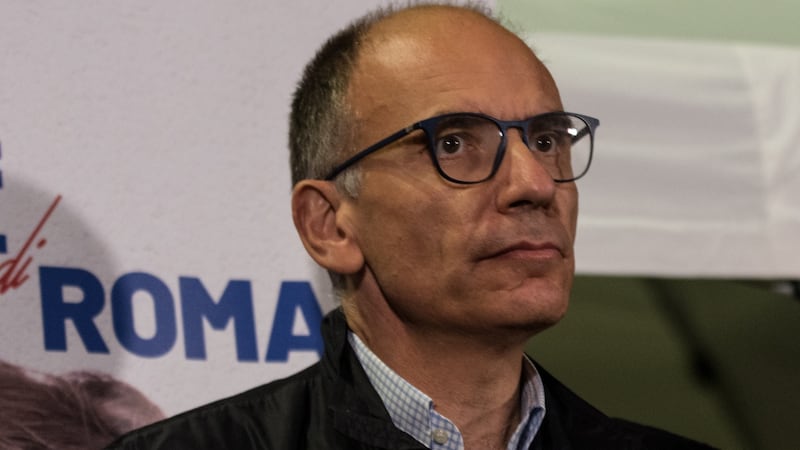In late October Italy's prime minister, Mario Draghi, took to the stage of a technical institute in southern Italy and told the audience of students that successive governments had failed them.
There had been “years in which Italy often forgot its young people”, he told the crowd in Bari, a city where youth unemployment has at times touched 50 per cent.
The country now stood at a historic moment, he continued, with Italy’s economically weak southern regions poised to receive an amount of investment “unprecedented in recent history”.
“It isn’t just your future that depends on education, it is ours, the future of all of us,” he said.
Draghi was in Bari to discuss investment in skills training, part of a plan to spend almost €200 billion in grants and loans jointly guaranteed by the 27 members of the European Union, including Ireland, in a vast stimulus plan to counteract the economic damage of the Covid-19 pandemic and fund a green and digital transformation of the continent.

At stake is whether Italy can turn around two decades of economic stagnation, in the face of demographic trends forecast to halve its population by 2100, and, in doing so, either vindicate or discredit the concept of joint EU borrowing, with implications for future EU integration.
Draghi is the former president of the European Central Bank, a non-politician appointed by Italy's fractious parties in February to lead them in an eclectic government of national unity, charged with steering the country out of the pandemic and setting up, with the European Commission, a programme of investments and reforms tied to the EU cash.
Honeymoon period
Seven months on, he’s enjoying a honeymoon notably more secure and prolonged than those of his reformist predecessors, who also carried high hopes – which ultimately gave way to disillusionment.
A reorganisation of the vaccination programme and stern Covid-19 pass mandates are credited with an adult inoculation rate approaching 90 per cent for at least one dose, accompanied by a stronger-than-expected economic rebound.
He cut a figure of gravitas as he welcomed world leaders to a smoothly run G20 in Rome, and received spontaneous applause at his concluding press conference, reflecting the slightly eerie mood of pervasive approval.
His approach so far was vindicated by local elections last month in which Draghi’s strongest supporters made gains while the Eurosceptic right-wing parties that pose the greatest challenge to his power ebbed in support.
Yet supporters of the prime minister say the advantage of this arrangement is that, as a technocrat who has not and will not compete in elections, he does not rely on public opinion for his job and can make difficult decisions that will pay off in the long term.
It’s something of a bleak assessment of Italian democracy, but one that reflects how demography can skew policy choices.
For years, Italian politicians favoured spending on the older voters who determined the outcome of elections, imposing successive rounds of cuts on education while maintaining the second-most generous pension system in the EU after Greece.
With cash tight, long-term investments were sacrificed to maintain current account spending, officials acknowledge. A gulf opened between older workers with iron-clad employment contracts and a younger underclass who worked off the books or in temporary jobs, without the stability to start a family. This compounded the demographic imbalance and spurred the emigration of the many bright young Italians who now staff Europe’s international institutions, top companies and research hubs.
The right moment
Draghi is far from the first prime minister with an ambitious reform agenda to turn it all around. He's not even the first Mario: that was Mario Monti, the one-time EU commissioner who was appointed to restore order after the Berlusconi years in 2011.
Yet Enrico Letta, another former prime minister who attempted to push through reforms at the head of a grand coalition, is convinced that the moment is right. He gave up an academic career abroad to return to Italy earlier this year and lead his old centre-left Democratic Party in Draghi's coalition.

“I was six years in Paris, and I saw there was a unique, favourable moment for rebuilding Italy. It’s a magic moment and I returned to try to help,” Letta said.
“It’s different this time, because this time there is money,” he explained. “In the last 20 years of history in our country, we always had to do reforms in a period of cuts. Every reform has winners and losers, and the losers do everything they can to stop the reform. You need to carefully manage the transition, and if there are no funds for that, you can’t do the reform. That’s my experience.”
Reforms
Italy’s problem is arguably not passing laws, but implementing them. It’s a stereotype among civil servants that new laws are passed by the government of the day, and go directly into a ministry drawer, where they sit on top of yellowing stacks of previous reforms. Attention soon fades amid Italy’s incessant political churn, and when a new government takes power, the changes are never followed through.
Draghi’s reforms so far have been ticking off the European Commission’s “Country Specific Recommendation” wish list. It started with so-called “enabling reforms”, to smooth the path for change with tweaks to the bureaucracy and civil service. There have been changes to the tax system and labour market, and this week a competition law was passed to reorganise key sectors.
One reform curtailed the length of Italy’s notoriously drawn-out judicial proceedings, a disincentive to overseas investors and source of impunity (a quarter of criminal proceedings in 2018 simply lapsed because they exceeded the statute of limitations during appeals).
On pensions, Draghi rowed back a 2019 law that allowed for early retirement at 62 for people with 38 years of contributions, with a plan for a gradual return to age 67 established by a still older reform – a warning in itself of how Italian governments can unpick the work of their predecessors.
For Alessandro Speciale, co-author of a hit biography of Draghi and Rome bureau chief for Bloomberg, the most promising policies are investments in the kinds of technologies that will underpin Europe's hoped-for greener, digital future.
"Italy has a very big industrial base. It's the second-largest industrial country in Europe, after Germany in exports. But it is way behind in all the really cutting edge sectors: batteries, digitalisation, artificial intelligence, semiconductors," Speciale explained.
“Now there is a lot of money for those. And by all means there are the people, and the industrial capacity to make it work. With this spirit of innovation and investment from the government, this could really plan the basis for a rosier future for Italy. But that’s a big ‘if’.”
Draghi has at most a year and a half left as prime minister as elections must take place no later than June 1st, 2023. He’s certain not to repeat the humiliating experience of his predecessor Monti by entering elections himself, and it’s a remote possibility that the circumstances would recur for the political parties to sublimate their own power and appoint him again.
Another possibility – the current obsession of political gossip in Rome – may curtail his time further. President Sergio Mattarella’s term ends in January, and Italy’s parliamentarians will have to hold a vote to appoint a replacement. Choosing Draghi to succeed Mattarella would, for some parties, remove a person who has overshadowed them. It would also give him a fatherly oversight of the reform programme he has begun for a presidential mandate of seven years, because in Italy the president plays an important role in brokering the formation of coalitions.
Could the politicians opt to get Draghi out of the way, and install one of their own to take charge as the euros start rolling in?
Officials insist that whoever enters office after Draghi will find the course is set. The jobs have already been handed out to the teams that will oversee the reforms.
A key role has been handed to an office within the finance ministry with a fearsome reputation among public officials: the Ragioneria Generale dello Stato, or state auditors, which, some credit, during the bad years with keeping Italy afloat.
One team within it will have the role of co-ordinating with local and regional governments to verify costs, offer support, identify best practices, and guard against infiltration by organised crime. Italy’s mafias have serious form in siphoning off EU funds.
Another will co-ordinate with the European Commission, ensuring that the required milestones are hit to keep the money flowing.
Meanwhile, in the gilded prime ministerial quarters of the Renaissance-era Chigi Palace, a political unit has been established to referee disputes where they arise over the spending of the funds, whether between ministries or rival territorial powers.
Fate of funds
There’s an awareness that on the fate of these reforms rests not just Italy’s economic future, but whether the EU will ever repeat the model of joint borrowing that underpins them – a development in the union’s co-operation that has long been the stuff of Italian political dreams.
“These arrangements are here to stay,” an Italian official said. “If this is indeed a format the EU may want to repeat, then recipient countries like Italy need to show they can deliver results.”
And on top of that rest the hopes of young people, like those whom Draghi addressed in Bari.
“If the reforms and the investments were to be successful,” said Speciale, “Ten years from now, 15 years from now, maybe bright Italians will have the opportunities to stay in Italy, as opposed to going abroad.”











